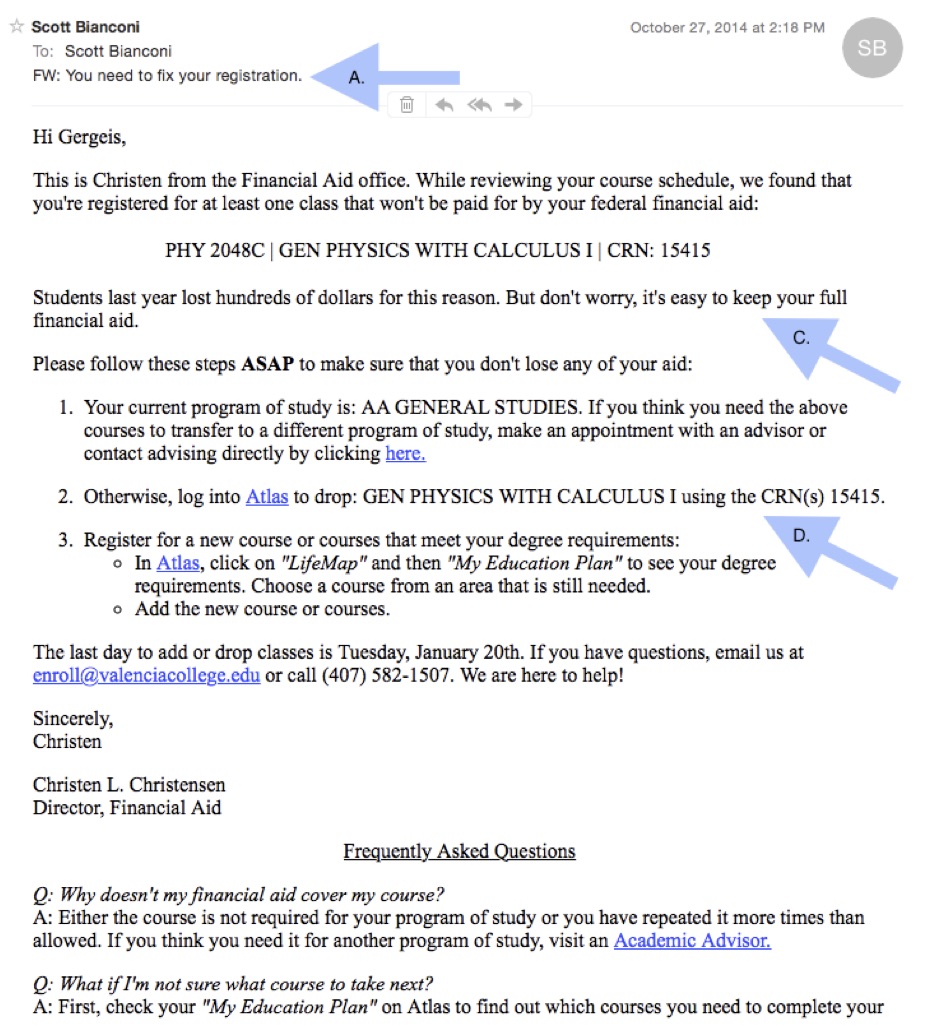
Emails About Course Selection Increase Financial Aid
Organization : ideas42
Project Overview
Project Summary
Students were sent two redesigned emails during the course selection process: a pre-registration email that laid out instructions and procedures for registration, and a post-registration email that notified students if any of their upcoming courses did not fit financial aid requirements.
Impact
The average aid award for students receiving both redesigned emails rose by $150.28 per student for the Spring semester compared with students who received neither email, with a total increase of $1.5 million earned in aid eligibility.
Cost
Helping the average student access an additional dollar of financial aid cost $0.18. However, the cost would decrease to $0.03 if these emails were implemented across the university.
Challenge
Under federal regulation, students’ financial aid may be reduced if they select courses that are defined by the school as being outside their declared course of study. About one in seven Valencia College students is at risk of losing some aid for this reason in any given semester.
Design
At Valencia College, ideas42 redesigned two emails that the school sends to students earning their Associate in Arts degree during registration: (1) a pre-registration email laying out instructions and procedures for the upcoming registration cycle, and (2) a post-registration email generated when a student has registered for a course outside of those eligible for financial aid under their declared major, which is intended to help the student take corrective action. The emails also made a point of highlighting only those courses that fit a student’s major by linking to an online listing of Associate in Arts course requirements.
To test the effectiveness of the redesigned emails, students were assigned to receive either only the redesigned “Pre” email, only the redesigned “Post” email, both redesigned emails, or neither.
Re-designed pre-registration email

Re-designed post-registration email

A. To ensure that students noticed and opened the emails in their inbox, subject lines conveyed the urgency of the message using a frank and action-oriented (e.g. “You need to fix your registration”) rather than frantic (e.g. “URGENT!!!”) tone that might lead students to procrastinate.
B. Both redesigned emails used simple phrasing, clear layout, and a conversational tone to make it easier for students to understand what they need to do and why.
C. To spur students to action, the emails combined a friendly, personalized touch with a clear mention of the possibility of losing “hundreds of dollars” in financial aid eligibility.
D. Numbered action steps—with embedded links so students could take action right at the moment of reading them—framed the most important information in the order that would produce best results for the student.
Impact

This randomized evaluation found that the average aid award for students receiving both redesigned emails rose by 2%, or $150.28 per student for the Spring semester, compared to students who received neither email ($6,368 vs. $6,217). Minority (nonwhite) students saw the greatest Spring semester increases of all, with 3% or $186.82 more in financial aid awards per student ($6,539 vs. $6,352).
Corresponding increases in credit load suggest that these improvements resulted from a more streamlined, guided, and focused registration process overall. Students exposed to both redesigned emails passed an additional 0.22 course credit (a 3% overall increase), even when accounting for extra course credits attempted.
The results also show that neither email intervention was responsible for meaningful improvements in either financial aid or academic indicators on its own; rather, most gains resulted from their combination.
Implementation Guidelines
Inspired to implement this design in your own work? Here are some things to think about before you get started:
- Are the behavioral drivers to the problem you are trying to solve similar to the ones described in the challenge section of this project?
- Is it feasible to adapt the design to address your problem?
- Could there be structural barriers at play that might keep the design from having the desired effect?
- Finally, we encourage you to make sure you monitor, test and take steps to iterate on designs often when either adapting them to a new context or scaling up to make sure they’re effective.
Additionally, consider the following insights from the design’s researcher:
- Both emails were sent using Banner software. The post-registration warning email was triggered using the Banner CAPP (Curriculum, Advising and Program Planning) module.
- Instead of using communications as a delivery channel, it would be preferable to build the intervention into the course registration system. For example, the system could (1) label courses as being aid-compliant or not aid-compliant, (2) prompt students to reconsider their choices if they select non-compliant courses in the registration system, and (3) immediately produce an error message when a non-compliant course registration is submitted.
- Some courses of study at Valencia and other colleges have more defined pathways with a required set of courses for students to complete within a defined time frame. In such cases, the intervention described here may not be necessary, and may not have the same effect.
For more guidance on implementing this design, select “I want to try this” from the left drop-down menu.


